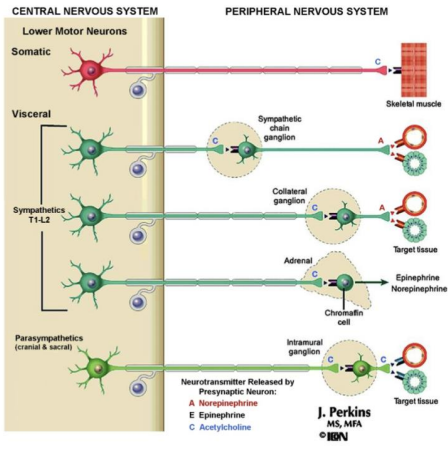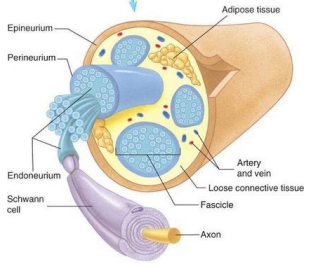Peripheral Nervous System (Pns)
For developmental details, see: Ectoderm - Neurulation > Neuroectoderm.
For anatomical details, see: Nervous System Primer
Organization
All of the following systems release acetylcholine to simulate their intermediate targets. The autonomic-sympathetic system will release norepinephrine and epinephrine (in the case of the adrenal medulla) to stimulate the final target. The autonomic-parasympathetic system will use acetylcholine to stimulate the final target.
For neurotransmitter lifecycle, see here: Synaptic Cell Biology > Key Neurotransmitter Metabolism

An exception to these rules are sweat glands which are part of the sympathetic system, but release acetylcholine at target cells.
Somatic Nervous System
Sensory signals and voluntary muscle movement.
Autonomic Nervous System
Responsible for either upregulating or downregulating stress response to stimuli. Sex counts as stressful, which may be more the case for some. While the autonomic system isn't part of the CNS, its inputs are passed through the hypothalamus which serves as an integration/filtering center before being shared with the brainstem.
Two opposite autonomic subsystems
- Sympathetic nervous system: Fight or flight
- Parasympathetic nervous system: Rest and digest
For more anatomical information, see here: Nervous System Primer > Autonomic nervous system
Enteric Nervous System
Regulates the muscles of the GI tract and passes along sensory info. Motor signals control peristalsis, churning, and sphincter muscles. Sensory output will provide information about distension and GI contents.
Modulated by sympathetic and parasympathetic nervous systems but will maintain homeostasis on its own. Ganglia sit between layers of GI muscle, innervating the muscles, epithelia, arterioles, and secretory cells.
Parasympathetic affects: Stimulates enteric nervous system (digestion) via vagus nerves and sacral splanchnic nerves
Sympathetic effects: Inhibits enteric nervous system (slow digestion) via lateral horn of spinal cord
Peripheral Cells
Sensory (afferent) neurons: Carry sensory information from the periphery towards the spinal cord/brain.
Motor (efferent) neurons: Carry motor information from the brain/spinal cord to the periphery.
Satellite cells: Located around cell bodies. Provide support for and protect neurons. Can also contribute to chronic inflammation and pain.
Schwann cells: Provide myelination
Size and Myelination
Impulses travel faster in larger and more myelinated fibers.
- Alpha motor neurons: Largest and most myelinated
- Beta sensory neurons: Large and myelinated, but not as much as alpha
- Gamma motor neurons: Thinly myelinated (innervate muscle spindles)
- C pain fibers: Small, unmyelinated, slow
- Autonomic neurons: Slow as they carry information to organs which has less urgency.
Nerve coverings
Protect the nerve as some areas like those with a lot of movement are more vulnerable. Around joints the fascicles (bundles of axons) are thinner, more numerous, and have thicker coatings.
Made of collagen, support cells, and blood vessels.
- Endoneurium (fills bundles): Fills space around individual axons outside Schwann cells
- Perineurium (around bundles): Surrounds axons or fascicles
- Epineurium (outside nerve): Outermost layer, merges with adipose tissue
